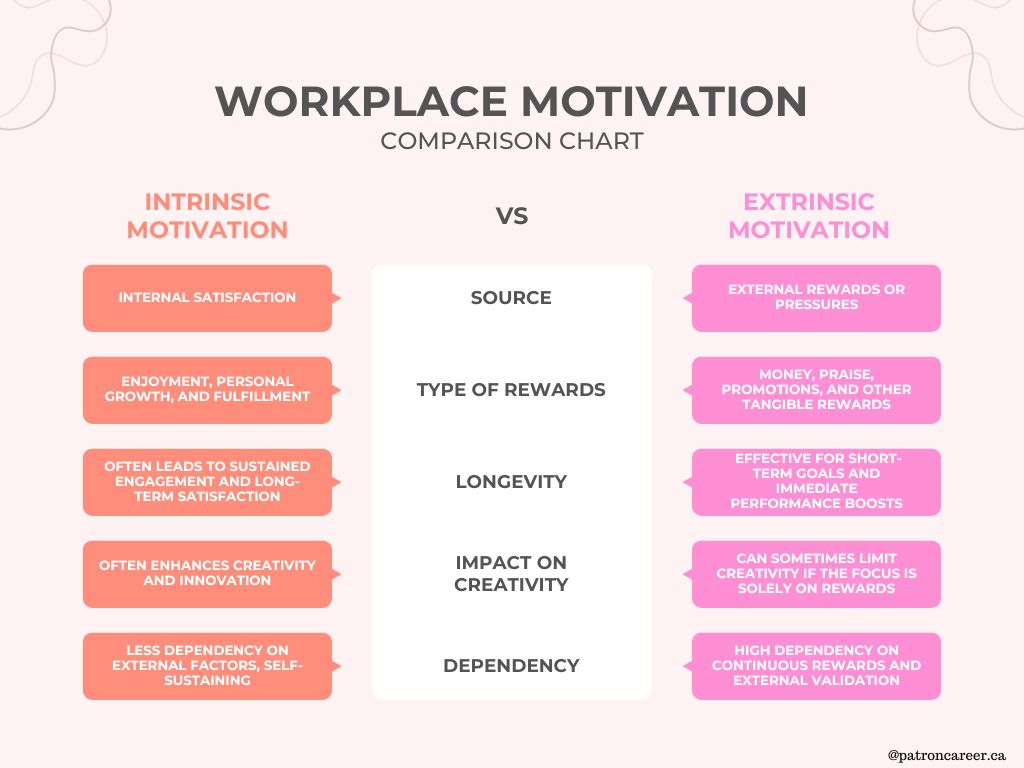
Employee’s Job Performance
18 April, 2024
Patron Career Staffing firmly believes in adopting a tailored approach to meet temporary and permanent recruitment needs. We safeguard the interest of our clients by finding such workers who are knowledgeable and reliable.
About UsNeed help? Make a Call
32 Dundas Street East Unit A, L5A1W2

Motivation is the most powerful yet substantial factor that drives productivity and job satisfaction in a workplace. Successful businesses focus on inspiring their workforce through intrinsic and extrinsic motivation, which greatly maximizes employee performance and ultimately leads to overall success. For employees to shun negative behaviours and outputs, they are required to be consistently rewarded with incentives, positive feedback or prompts. It helps bring up their drive to succeed at the given tasks and yield great results.
In the realms of the business world, harnessing extrinsic motivation in the workplace has become more pressing. HR experts have to gear up in skills and knowledge to understand what brings employees to maximize their potential and how to effectively leverage extrinsic motivational strategies to foster a satisfying and productive work environment. Additionally, we explore the pros and downsides of extrinsic motivation and its real-world examples in the workplace.
What is Extrinsic Motivation?
Extrinsic motivation is the proclivity to perform well and succeed to gain external rewards such as praise, grades, money or recognition. For instance, an employee may be putting his nose to the grindstone in order to complete his project before the deadline to receive a bonus or to avoid an admonishment from his boss. Essentially, this type of motivation arises from outside the individual and is not backed by internal satisfaction. This phenomenon is grounded in operant conditioning where individuals learn from experiences or consequences. Let's say an employee makes a decision for which he is praised, he will more likely tend to make a similar choice in his future endeavours.
Extrinsic vs. Intrinsic Motivation: Understanding the Difference
Two types of motivation drive organizational behaviours: intrinsic and extrinsic. Here’s a breakdown:
Intrinsic Motivation
Extrinsic Motivation

What is Self-Determination Theory?
Developed by psychologists Edward Deci and Richard Ryan, the Self-Determination Theory originates from the role of intrinsic motivation and identifies three basic psychological needs that are essential for fostering it: autonomy, competence, and relatedness.
SDT not only accentuates the value of intrinsic motivation but also acknowledges the role of extrinsic motivation. It posits that extrinsic rewards can further support intrinsic motivation so long they align with a person’s sense of autonomy and competence.
The Need for Extrinsic Motivation in the Workplace
Organizations require extrinsic motivation tactics in the workplace for a variety of reasons:

Pros of Extrinsic Motivation in the Workplace
Employers benefit from using extrinsic motivation in the workplace.
Pitfalls of Extrinsic Motivation in the Workplace
8 Examples of Extrinsic Motivation in the Workplace
Below are some examples of extrinsic motivation in the workplace:

How to Use Extrinsic Motivation Effectively
Every employer should be abridged of the importance of extrinsic motivation and how to harness its power most strategically to yield the best results.
A Word From PCS
In any workplace, employees can flourish from the use of extrinsic motivators like money, gift cards, promotions or public praise. One should look for ways to balance extrinsic and intrinsic motivators to maintain long-term productivity and satisfaction at work. To get the maximum results, first reflect on your workplace motivation programs and consider integrating a balanced approach for optimal output.
